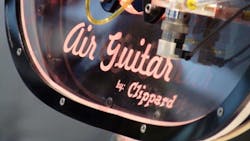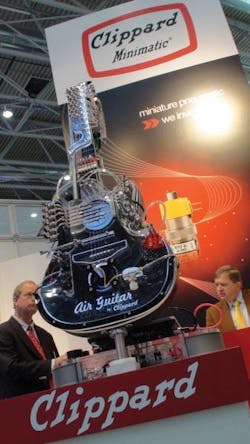Once again, Clippard Instrument Laboratory will be showcasing its pneumatic “Air Guitar” at PackExpo this year, highlighting its pneumatic valves and cylinders.
According to Rob Clippard, Business Development Manager, the air guitar, which he and a small team built in 2010, is a modified ovation series guitar. The instrument is controlled by 56 standard electronic valves and 62 miniature stainless-steel cylinders ranging from 5⁄32 to ½ in. bore.
“These cylinders mimic the motions of a guitarist’s fingers and have the added benefit of repeatability to the millisecond and speed, but they don’t have to take breaks in between sets,” Clippard said.
The miniature electronic valves are ideal for the application because they operate virtually without noise. “Most of the click you hear is due to the cylinders’ motion and not the valves,” Clippard explained. “All valves are supplied with either 50 or 25 psi depending on the Marcato, or strength of the note. The Legato or staccato (length) is a function of the timing.”
The electronic valves are powered with 24 Vdc and driven by a midi driver controlling a series of relays. This interface board allows the use of off-the-shelf music editing software. The user assigns notes, mutes, strum, or percussion. The software is housed in an iPad. A wireless card built into the guitar provides control via WiFi and a smart phone. The guitar’s repertoire includes more than 16 original and familiar tunes.
Clippard said the biggest challenge was getting the instrument to sound good. “The fretting motion, done by 36 different 5⁄16 in.-bore cylinders, hit the string perfectly. It sounded great. But coming off of the string as quick as they did was a problem. It would vibrate the string a second time, essentially playing the tuned string’s main note, ruining the song,” Clippard described. “This was overcome by adding a mute to each of the six strings that would programmatically touch the string after any fret was played. This also allowed us to play certain harmonic notes by locating the mutes in the right places.”
For more information or to see a video of the guitar, visit www.clippard.com. See the guitar at PackExpo in Clippard’s booth 1469.
See a video of Clippard's "pneumatic tree guitar," another tradeshow invention, at www.machinedesign.com.
About the Author

Leaders relevant to this article:

